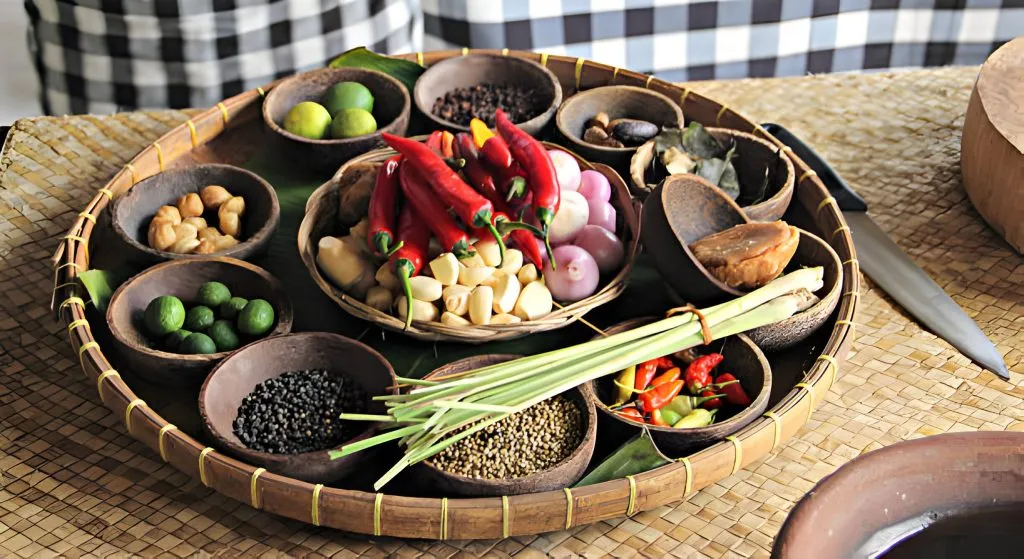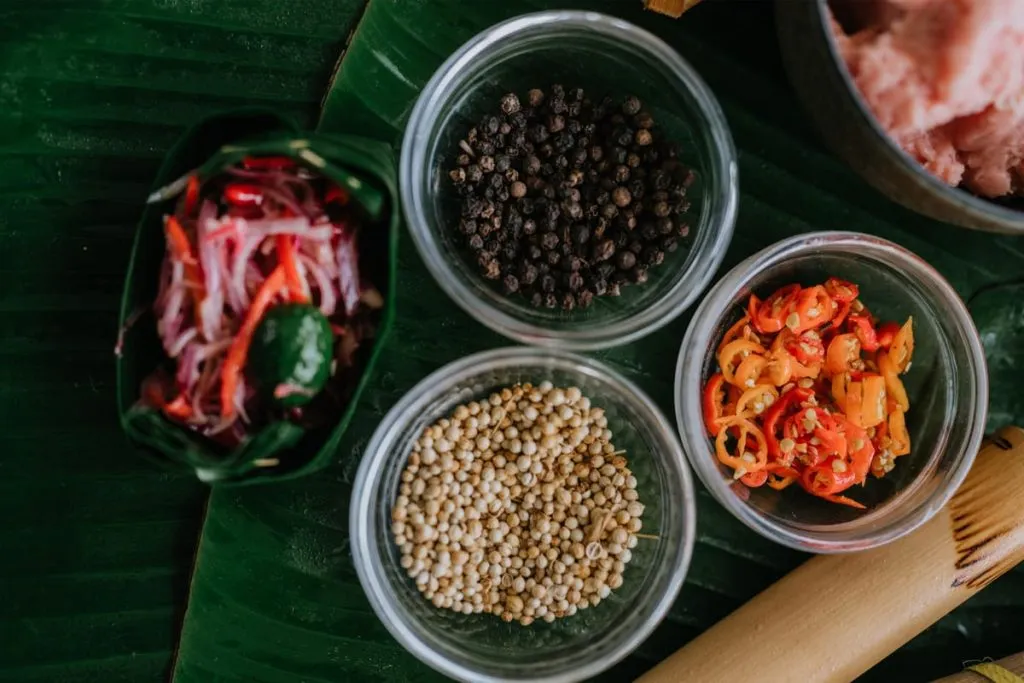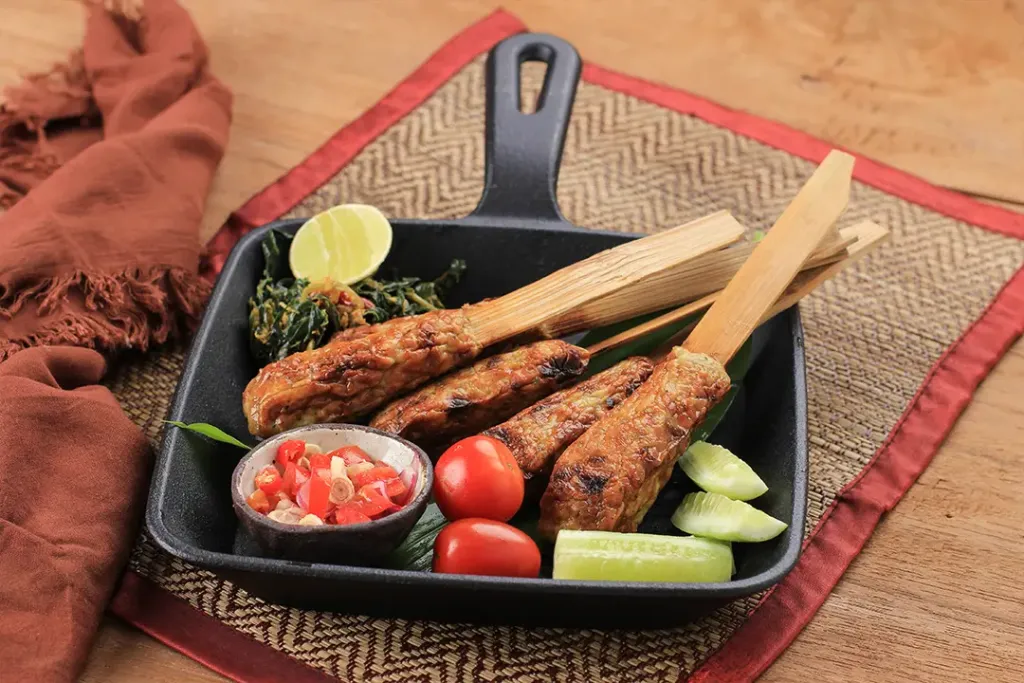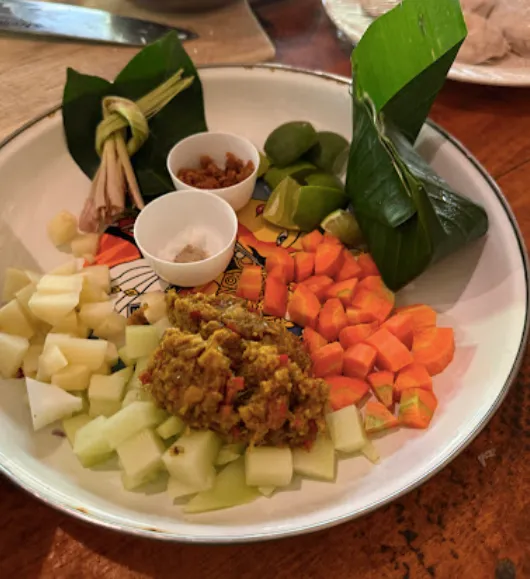Where Flavor Meets Spirit
If you’ve ever wandered through a Balinese market early in the morning, you’ve probably caught that unmistakable aroma — a swirl of lemongrass, galangal, shallots, and toasted coconut. It’s not just food being prepared; it’s heritage in motion. On the island of the gods, cooking isn’t merely about taste. It’s a living expression of balance, community, and gratitude.
At the heart of it all lies what locals call bumbu Bali — the intricate blends of herbs and spices that define the soul of Balinese cuisine. These are not just ingredients. They’re stories, rituals, and the invisible thread connecting past and present.
In this guide, we’ll explore the world of Balinese spices, with a close look at the two most important foundations: base genep and base rajang. You’ll learn what goes into them, how they’re made, and how they bring life to the dishes that make Bali unforgettable.

1. Understanding Balinese Spices: More Than Just Flavor
Balinese food stands out in Indonesia because of its intensity — layers of heat, aroma, and depth that feel almost orchestral. The secret lies in its spice philosophy.
Rather than using a single seasoning or pre-made powder, Balinese cooks create bumbu — aromatic pastes freshly ground every day. Each mixture is a harmony of sweet, spicy, sour, and earthy notes. And while every region has its own variation, they all share the same belief: spices are not only for flavor but also for balance and well-being.
Traditional healers (balian) in Bali have long considered spices like turmeric, ginger, and galangal as both food and medicine. So when you taste a Balinese dish, you’re tasting centuries of cultural memory — a fusion of nourishment, ritual, and health.
2. The Foundation: Base Genep — The Complete Spice Mix of Bali
Ask any Balinese cook what defines their cuisine, and they’ll answer without hesitation: base genep. The term literally means “complete seasoning,” and it lives up to its name. It’s the mother of all spice pastes, used in everything from grilled fish to ceremonial dishes like lawar and bebek betutu.
Ingredients
Every family may have its version, but the classic base genep includes:
- Shallots
- Garlic
- Galangal
- Turmeric
- Ginger
- Lesser galangal (kencur)
- Candlenuts
- Coriander seeds
- Black peppercorns
- White pepper
- Red chili (sometimes mild, sometimes fiery)
- Lemongrass
- Shrimp paste (terasi)
- Palm sugar
- Salt
Coconut oil or water is often added during the grinding process to help the ingredients blend smoothly.
Preparation
Traditionally, everything is pounded by hand using a stone mortar (cobek). This process can take time, but it’s essential. The act of grinding slowly releases the natural oils and aromas that define base genep’s character.
Once the mixture reaches a thick, rich paste, it can be sautéed until fragrant — the step known locally as mesambel. The result is a golden, spicy, deeply aromatic base that forms the backbone of countless Balinese dishes.
Use in Daily Cooking
From the street-side warung to royal palace kitchens, base genep finds its way into almost everything. It’s used to marinate meats, stir-fry vegetables, and season soups. In ceremonial contexts, it’s part of offerings to the gods, symbolizing completeness and balance in life.
In other words, base genep is not just a seasoning. It’s a reflection of how Balinese people view harmony — the unity of the physical, spiritual, and natural worlds.
3. The Everyday Magic: Base Rajang — Simpler, Fresher, Faster
If base genep is the grand symphony of Balinese cooking, base rajang is its acoustic version — simple, fresh, and full of character.
The word rajang means “to chop finely.” Instead of being pounded into a paste, the ingredients are sliced thin and sautéed together. This gives the food a brighter, crunchier texture and a lighter flavor.
Ingredients
A typical base rajang contains:
- Shallots
- Garlic
- Red chilies
- Lemongrass
- Galangal
- Turmeric
- Kaffir lime leaves
- Sometimes tomatoes or shrimp paste
This combination can be adjusted depending on the dish — for instance, less chili for vegetables or more lemongrass for seafood.
How It’s Used
Because it’s easier and quicker to prepare than base genep, base rajang is used in everyday home cooking. You’ll find it in stir-fried vegetables (sayur urab), grilled fish, and sautéed tofu.
Its fresh, sharp flavor is perfect for balancing heavier dishes or for adding brightness to fried foods. Many Balinese families prepare base rajang in the morning and keep it in jars to use throughout the day.

The Difference in Spirit
While base genep feels ceremonial, base rajang feels intimate — the taste of home kitchens, morning markets, and the hum of daily life. Together, they form the backbone of what the world recognizes as authentic Balinese flavor.
4. Variations and Regional Twists: The Diversity of Balinese Spices
Even within the small island of Bali, spice blends differ by region and occasion. Some cooks add extra turmeric for color; others rely heavily on chilies for heat. Here are a few notable variations you might encounter:
a. Base Wangen
This aromatic blend is similar to base genep but enhanced with fragrant roots and spices like cloves and nutmeg. It’s often used for ceremonial dishes and temple offerings.
b. Base Be Pasih
A lighter spice mix used primarily for seafood dishes. It omits the heavier roots and focuses on lemongrass, lime leaves, and coriander for freshness.
c. Base Nyuh
A spice mix that incorporates grated coconut, giving it a creamy texture and a nutty aroma. It’s used in vegetable dishes and sometimes desserts.
d. Base Kuning
As the name suggests (“kuning” means yellow), this base uses turmeric as its dominant spice. It’s often used for chicken and rice dishes.
Each variation represents a different facet of the island’s culinary geography. Exploring them is like traveling across Bali through taste alone.
5. The Role of Spices in Balinese Culture and Rituals
Balinese food doesn’t exist in isolation. Every ingredient and spice blend carries symbolic meaning. Cooking, for many, is an act of devotion.
Spices like turmeric are believed to purify; chilies represent energy and protection; garlic and shallots symbolize the cleansing of negative forces. That’s why spice pastes like base genep are not only cooked for humans but also offered to deities in small woven baskets called canang sari.
In major ceremonies such as weddings, cremations, or temple festivals, food plays a key role in connecting the community. Every offering is seasoned with intention, reinforcing the Balinese philosophy of Tri Hita Karana — the harmony between humans, nature, and the divine.
To understand Balinese spices, then, is to understand Bali itself — its faith, creativity, and deep sense of balance.

6. Cooking with Balinese Spices: Techniques and Tips for Beginners
You don’t have to be in Bali to bring its flavors to your kitchen. With a few simple techniques and some fresh ingredients, anyone can recreate the warmth of the island.
a. Use Fresh Ingredients
Balinese spices depend on their natural oils. Always use fresh roots like turmeric, ginger, and galangal instead of powdered versions whenever possible.
b. Balance Heat and Aroma
Balinese food isn’t about burning spice; it’s about layered flavor. Adjust chili levels to your liking but keep the aromatic roots and herbs strong.
c. Don’t Rush the Sauté
When cooking base genep, take time to sauté until it releases a deep, golden aroma. That’s when the flavors fully bloom.
d. Store Thoughtfully
You can store spice pastes in airtight jars in the refrigerator for up to a week. For longer storage, freeze them in small portions. By practicing these steps, you’ll not only cook Balinese food — you’ll experience a rhythm that connects you to generations of island cooks.
7. Beyond the Kitchen: The Global Allure of Balinese Spices
Today, bumbu Bali is crossing borders. Chefs around the world are incorporating Balinese spice blends into modern dishes — from grilled meats to plant-based cuisine.
The complexity of base genep makes it a natural fit for fusion cooking, while base rajang adds freshness to salads and seafood. Even vegan chefs love using Balinese spices for their rich, umami depth without relying on animal ingredients.
Beyond gastronomy, the growing interest in wellness has also boosted these spices’ global reputation. Turmeric lattes, ginger tonics, and herbal infusions all trace their roots to the same healing traditions that shape Balinese cooking.
8. How Balinese Spices Support Sustainable LivingAnother reason bumbu Bali deserves recognition is its link to sustainability.
Many Balinese families grow their own herbs and spices — turmeric, lemongrass, galangal, and chili often thrive in backyard gardens. By relying on what the land naturally offers, local cuisine promotes low waste and ecological balance. Coconut shells become charcoal, banana leaves serve as natural wrappers, and leftover spice paste can be turned into marinades.
This deep respect for the environment mirrors the Balinese belief that cooking should never take more than nature can give. It’s a philosophy the modern world could learn from.
9. Experiencing Balinese Spices: From Kitchen to Culture
Tasting Balinese food is a sensory experience, but making it is an act of understanding. When visitors join a local cooking class or walk through a spice garden, they often realize that the real flavor of Bali isn’t just in the ingredients — it’s in the stories behind them.
Watching a Balinese cook pound base genep with quiet precision or slice chilies for base rajang is like watching a ritual that has survived centuries. It’s this living tradition that keeps the island’s cuisine both ancient and alive.
If you’re visiting Bali, take the time to explore beyond the beaches and cafés. Visit traditional markets in Ubud, Sidemen, or small villages like Tamandukuh, where you can see — and smell — Balinese spices in their natural home.
The Soul of Bali, Captured in a Spoonful
Balinese spices are more than a recipe — they’re the essence of an island that cooks with heart, faith, and joy. From the complete depth of base genep to the simple freshness of base rajang, every paste tells a story of connection: to nature, to culture, and to one another.
When you taste Balinese food, you’re tasting balance. You’re tasting community. You’re tasting life on the island of the gods.

Experience Balinese Spices: From Kitchen to Culture
There’s something magical about watching Balinese spices come to life in a traditional kitchen. The air hums with rhythm — the gentle tap of a pestle against stone, the whisper of shallots hitting hot oil, the burst of lemongrass scent as it meets the flame. Here, cooking isn’t just a daily task; it’s an art form, an unspoken language passed down through generations.
To truly understand Balinese cuisine, you can’t just taste it — you have to make it. That’s where the island’s spice traditions reveal their secrets. Every ingredient, from turmeric to galangal, has a purpose and personality. And when you grind them together by hand, you begin to sense the story of the island beneath your fingertips — the same story that lives within every jar of Balinese spices.
At Taman Dukuh Cooking Class, this story comes alive. Nestled in the heart of rural Bali, surrounded by lush rice fields and coconut palms, this hands-on experience invites you into the rhythm of local life. It’s not a show behind a counter — it’s participation, discovery, and joy. You’ll visit a traditional market to pick fresh ingredients, guided by friendly local chefs who’ll show you how to choose the perfect lemongrass stalk or the ripest chili, explaining how each one shapes the balance of Balinese spices.
Back in the open-air kitchen, time slows down. There’s laughter, curiosity, and the sound of stone mortar grinding fresh base genep — the golden paste that forms the foundation of Balinese cooking. Your instructor doesn’t just tell you what to do; they share why. Why certain Balinese spices are used at specific times. Why some blends are meant for ceremonies, and others for daily meals. Each explanation ties you closer to the culture that shaped these flavors.
For beginners, it’s a gentle adventure. Even if you’ve never cooked Indonesian food before, the class guides you through each step patiently. You start with simple chopping, then move on to blending your own bumbu Bali. Before long, the air fills with your creation — a fragrance that feels both ancient and new. It’s hard not to smile when you realize: you’ve just mastered authentic Balinese cooking using real Balinese spices.
By the time you sit down to taste your meal, something changes. It’s not just food anymore; it’s connection. You’ve shared stories with your instructor, laughed over spice splashes, and discovered that behind every Balinese dish lies intention — balance, gratitude, and care. The flavors taste deeper because you’ve earned them.
Many visitors say it’s the highlight of their trip — not because it’s fancy, but because it’s real. You walk in as a traveler and leave with the confidence of a Balinese home cook, carrying memories (and recipes) that linger long after the flight home.
So if you’re curious to uncover the true essence of Balinese spices, this is where your journey begins. Step into the kitchen, roll up your sleeves, and let the island guide your senses.
👉 Book your spot at Taman Dukuh Cooking Class — where every chop, stir, and taste turns you from a curious visitor into a Balinese chef at heart.





